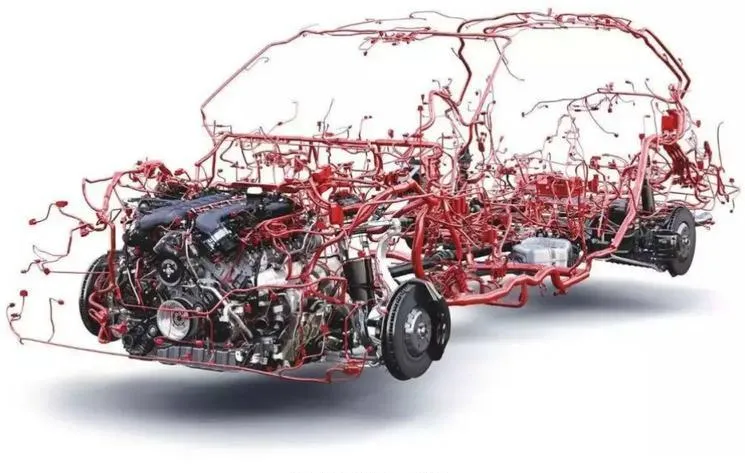Industry Overview
The automotive wiring harness industry is a crucial segment of the broader automotive parts sector, exhibiting a strong reliance on the development of the automotive manufacturing industry. Direct clients of wiring harness companies include automotive original equipment manufacturers (OEMs), engine manufacturers, and producers of vehicle electrical devices; notably, these entities do not engage directly with end consumers or the automotive aftermarket. Within the procurement costs of whole vehicles, the total cost of wiring harnesses typically comprises 2% to 5%.
The product design of automotive wiring harnesses encompasses various aspects of vehicle design, including electronic integration, mechanical specifications, and thermal distribution. Moreover, during the early stages of vehicle development, it is essential for wiring harness manufacturers to collaborate closely with OEMs to design products while continuously providing prototypes for experimental enhancements. Thus, the relationship between wiring harness enterprises and automotive OEMs is both intimate and symbiotic.
Market Dynamics
Joint Venture Preferences: Joint venture automotive brands tend to favor long-term, stable partnerships with multinational wiring harness companies such as Yazaki Corporation, Sumitomo Electric, Leoni, and Aptiv.
Chinese Brand Strategies: Chinese automobile brands are more inclined to establish or take controlling stakes in local wiring harness enterprises such as Zhejiang Haoda, Baoding Mande, and Fudi Technologies.
Supply Chain Characteristics
The wiring harness industry has a pronounced correlation with upstream industries, and its development is heavily dependent on the automotive manufacturing sector. Major corporations typically possess extensive upstream and downstream resources to ensure competitiveness. The automotive wiring harness industry connects to a broad array of upstream supply chains, including those involving wires and cables, connectors, protective tubing for harnesses, rubber products, cable ties, and other fastening components, alongside relevant raw material sectors such as copper, high-polymer composites, and aluminum.
Vertical Integration: Many multinational wiring harness firms often exert control over certain upstream suppliers. For example:
- Companies like Yazaki, Sumitomo Electric, Leoni, Furukawa Electric, Tencor, Kalloop, and Jingshin began their journeys as manufacturers of wire and cable products.
- Sumitomo Electric and Furukawa Electric even own their own copper mines.
- Yazaki, Sumitomo Electric, Aptiv, and Furukawa Electric are significant suppliers in the global automotive connector market.
- Sumitomo Electric is also a key global supplier of heat shrink materials.
These multinational wiring harness enterprises frequently engage in the research and development of automotive electrical and electronic architectures (E/EA systems). By integrating upstream and downstream resources, they not only maintain the competitiveness of their products but also generate substantial profits by supplying other harness manufacturers.
Production Characteristics
The automotive wiring harness sector represents a typical model of processing incoming materials per order. During the design and manufacturing processes of automotive wiring harnesses, the selection of raw materials and components is often directly specified by the development teams of automotive OEMs. In most instances, wiring harness companies must seek reputable lower-tier suppliers based on the specifications defined in customer blueprints.
Order Characteristics:
- Variety across multiple models
- Small batch sizes
- Short production cycles
- Frequent changes
These characteristics are reflected in procurement requirements: diverse types and specifications of raw materials needed, multitude of raw material suppliers, small procurement volumes for individual specifications, and demand for timely procurement cycles. Foreign brands typically contend with longer procurement cycles for raw materials.
Industry Challenges
- Low Added Value: The automotive wiring harness sector is marked by low added value and labor-intensive processes.
- Automation Difficulties: With a wide array of product types, complex manufacturing techniques, and short product lifecycles for many wiring harness items, the implementation of intelligent technology and industrial robotics faces significant challenges, contributing to the generally low level of automation within this industry.
- Labor Cost Pressures: Within the operational expenses of wiring harness enterprises, labor costs represent a significant factor that cannot be overlooked. Given the pronounced cyclical nature of annual automotive production and sales, wiring harness companies must simultaneously ensure capacity to meet peak production demands while managing personnel flows during off-peak times.
- Inventory Management Challenges: To maintain a zero-inventory approach, automotive OEMs transfer a substantial portion of their inventory pressure onto component suppliers, including wiring harness enterprises. Fluctuations in sales of specific models directly influence the order volumes and structures faced by wiring harness businesses.
- Procurement Cost Control Difficulties: The distinct order characteristics and procurement requirements of the industry, alongside the prolonged raw material procurement timelines faced by foreign brands, inevitably result in inventory accumulation and an urgent need for spot procurement, exacerbating the challenges of procurement cost control for harness manufacturers.
By understanding the characteristics and challenges of the automotive wiring harness industry, we can better grasp the dynamics and future trends of this crucial automotive component sector.

